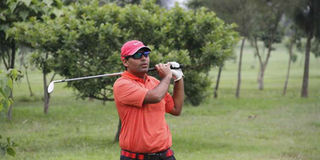Captains, borrow a leaf from Muthaiga on running big events

Bhavnish Chandaria follows his shot during the 2015 Kenya Amateur Match play championship at Vetlab golf club on June 17, 2015. PHOTO | MARTIN MUKANGU |
What you need to know:
- As is expected with such events, there were more golfers than slots available to play. Those of us who were lucky to get slots to play, were reminded even as the draw was being sent, to stick to the allotted tee times. We were expected to report to the starters seven minutes before out slots.
- I witnessed something very rare on the Kenyan golfing scene; the starters stuck to the starting times. That was not all; Organisers reminded golfers that there would be no half-way break.
- What should a golfer do when he finds himself in a situation where he is either unsure of the application of a rule or has a disagreement with his fellow players?
The Chairman of Muthaiga Golf Club, Bhavnish Chandaria, hosted golfers to a well-sponsored two-day Chairman’s prize.
As is expected with such events, there were more golfers than slots available to play. Those of us who were lucky to get slots to play, were reminded even as the draw was being sent, to stick to the allotted tee times. We were expected to report to the starters seven minutes before out slots.
Not that it should be necessary to remind a golfer that he or she needs to be at the tee well in advance of their tee time.
I witnessed something very rare on the Kenyan golfing scene; the starters stuck to the starting times. That was not all; Organisers reminded golfers that there would be no half-way break.
Sure enough, when we finished the first nine holes, they promptly reminded us that we were only allowed to pick a bottle of water and a snack and to immediately proceed to the second nine. This meant that the time most golfers waste with the halfway breaks was used to accommodate more golfers on the draw.
On the first day, when my four ball and I were on the second nine, I noticed that we were no longer able to keep up with the group in front of us. We had been right behind them on the first nine. It is not that we were playing particularly badly.
They seemed to have miraculously picked up their pace. It was not until the last hole that I discovered that they were no longer a four ball but a three ball.
Their fourth player had taken off after the first nine. Was he injured? Did he have an emergency that required him to leave? No. He was just one of the moneyed louts who have recently taken up the game but should be playing ajua instead and not be allowed to get anywhere near a golf course.
WAKLED OFF FROM COURSE
How else would you describe a man who walks off from the course, without informing his fellow golfers? He even got one of the golfers disqualified because he took off with the player’s scorecard.
This was due to a fit of pique occasioned by the denial of a free drop.
Apparently, this ajua player’s ball ended up near a water hazard after a stroke. His stance was impeded by the water hazard and he promptly called for relief. His fellow players denied him the free drop.
What is not clear to me is whether the water hazard that interfered with his stance had an artificial surface such as a wall. You will find these on some of the water hazards in Muthaiga Golf Club.
If this was the case, and if his ball was not lying within the margins of the water hazard, he was entitled to free relief. A golfer is allowed relief from “obstructions” in such a case. An “obstruction” is defined as anything artificial including the artificial surfaces and sides of roads and paths.
However, if the water hazard did not have any artificial surface, the ajua player should have played the ball as it lay, or deemed his ball unplayable. The other golfers in the group did not think that he deserved relief and this led to the ajua player throwing his toys out of the pram.
What should a golfer do when he finds himself in a situation where he is either unsure of the application of a rule or has a disagreement with his fellow players?
In such a situation, in a stroke play competition, the player may complete the hole with two balls. The player should first announce to his marker or his fellow competitors that he wishes to complete the hole with two balls.
He should also say which ball he wishes to count if the Rules permit the procedure used for that ball.
Before returning his score card, the player must report the facts of the situation to the Committee. If golfers understood this Rule, they would avoid a lot of misunderstandings on the golf course especially when they feel certain of the application of Rule and their fellow golfers are telling them something contrary.
There are two caveats however to this Rule; it does not apply to match play and if the player does not report to the Committee before returning their card, they are disqualified.
All in all, Bhavnish Chandaria hosted us to a very well organised event. For someone who has represented Kenya in events from when he was a junior golfer, playing with the likes of Sergio Garcia, he is well versed in how good tournaments should be run.
Other captains can borrow a leaf from Muthaiga on how to run big competitions. However, keep ajua players out of the game.
The author is a KGU Executive




